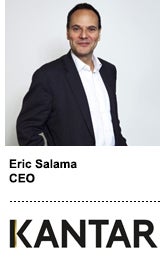Kantar didn’t have much flexibility under WPP to buy companies and solutions to modernize its traditional market research business.
“We’ve been out of the market for three or four years,” said Kantar CEO Eric Salama on a press call held Thursday to provide an update on its strategy under its new owner Bain Capital.
But now that the company is majority-owned by Bain after a $4 billion transaction in July, it’s eager to hunt for targets that can help it develop capabilities around ecommerce, analytics, technology and behavioral data.
“We’re looking to ramp up our acquisitions in a way that we haven’t been able to over the past couple of years,” Salama said. “We’re looking for capabilities that will enhance what we do for clients that we can’t develop ourselves as quickly as we need to.”
Salama didn’t mention any specific acquisition targets on the call, but he was clear that the company, which provides TV ratings and market research data to brands across the world, needs to invest more in automation and real-time analytics in today’s fast-moving industry.
“We’ve done lots of good things over the past few years but we need to do more,” Salama said. “Having a partner like Bain from a capability and money point of view will be helpful.”
Kantar will also scale some of its newer innovations across the globe, like its self-serve analytics platform Kantar Marketplace, a trade optimization tool for CPGs and a holistic brand tracking tool that uses shorter surveys and real-time data for quicker and more efficient turnarounds.
“We’re going from brand tracking that’s largely backward looking and too expensive to being much more real time and across the board,” Salama said.
Kantar also aims to measure content across all devices as media owners expand to new distribution platforms. Kantar recently signed a partnership with television ratings firm BARB in the UK to measure all IP traffic coming into UK households that participate in its panel.
The firm has also expanded its Worldpanel, which measures CPG and FMCG transacts through retail point of sale data, to capture individual shopper behavior with real receipts. Analyzing receipts against an internal database lets Kantar understand what people are buying, how new packaging affected a sale and a customer’s brand loyalty.
Kantar has also picked up clients in new categories like hardware, apparel and ecommerce thanks to its Worldpanel offering. Kantar is one of Apple’s biggest partners in measuring consumer smartphone shopping and operating system trends, and is also working more closely with big tech firms like Google, Baidu, Alibaba and Snap as they seek more qualitative research on consumer behavior.
“Historically they’ve placed a premium on leveraging behavioral data,” Salama said. “But now they want to get into understanding the ‘why,’ which they can only do through a combination of behavioral data and our attitudinal data.”
While Kantar has rolled out more than 40 machine learning and AI products to do things like predict panel fraud and classify social media investment, it plans to double down on automation to power all of its products. And it will invest in broadening its talent pool to hire more specialists, consultants and engineers to work with clients using these products.
“We’re putting a big emphasis on real-time and predictive offers and much faster turnaround,” Salama said. “We expect our overall workforce to grow but the mix to change.”
While Kantar has a fair amount of work to modernize and scale its product offering, Bain saw potential in the company’s solid client roster and a growing need for clients to use data and analytics to power and optimize their businesses.
Salama declined to share how much more Bain plans to invest in Kantar over the next few years.
“Bain saw an industry full of potential,” Salama said. “They also saw an industry that really needs to transform itself. We all see clients wanting to do be data-driven, or insight-driven marketing companies.














